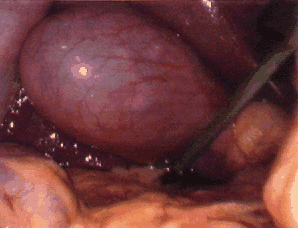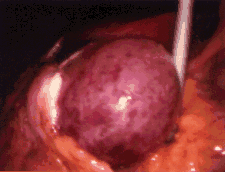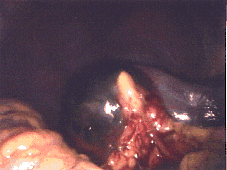|

|
Acute Cholecystitis:
I'm Having a Gallbladder Attack
These slides depict the stages of
an acute gallbladder attack or acute cholecystitis. The first
shows the grayish appearance of an edematous gallbladder. The
gallbladder wall has swollen and retained water and is edematous.
There is an obstruction of the cystic duct and the gallbladder
begins to swell. It no longer has the "robin egg blue" appearance
of a normal gallbladder.

As the acute cholecystitis progresses,
the gallbladder begins to become necrotic and gets a speckled
appearance as the wall begins to die.

Finally, the gallbladder undergoes
gangrenous change and the wall becomes very dark green or black.
This is the stage when perforation occurs.

Gallbladder Problems
Fair, fat, forty,
female; all adjectives to describe that person most at risk
of developing symptomatic gallstones. Gallstones
can occur at anytime from childhood to late in life but may
not become symptomatic right away. Small children have rarely
developed sympotmatic gallstones that have had to be surgically
removed. Adolescents will at time have recurrent attacks of
upper abdominal pain that are related to gallstones. Ususally
these children have a family history of gallstones. Gallstones
can result from rapid weight loss and may form during pregnancy.
The stones form as bile salts form precipitates within the stagnant
gallbladder. They may become symptomatic when they are 1 mm
in diameter or remain silent until the person is in their 90s
and has a 4 cm gallstone. The smaller the stone, the more apt
they may be to migrate into the common bile duct to produce
jaundice or pancreatitis.
In medical school, "doctors-to-be"
are taught that symptomatic gallstones cause severe attacks
of right upper quadrant pain. This is one subset of the patients
that eventually will need an operation to remove the gallbladder
and the stones. Some doctors only remember this set of patients
and do not consider the pain in the upper back between the
shoulder blades or the chest pain that mimics a heart attack.
If you have chest pain, it is far better to have your heart
checked out first before ascribing the pain to gallstones.
Gallstones can cause lessor degrees of discomfort including
bloating, belching and indigestion. Fortunately one of the
worst complicatons of gallstones is fairly rare. Pancreatitis
is the most feared complication of gallstones and presents
with pain in the mid abdomen that radiates into the back.
It is also the one complication of this condition that is
potentially lethal.
|
|

